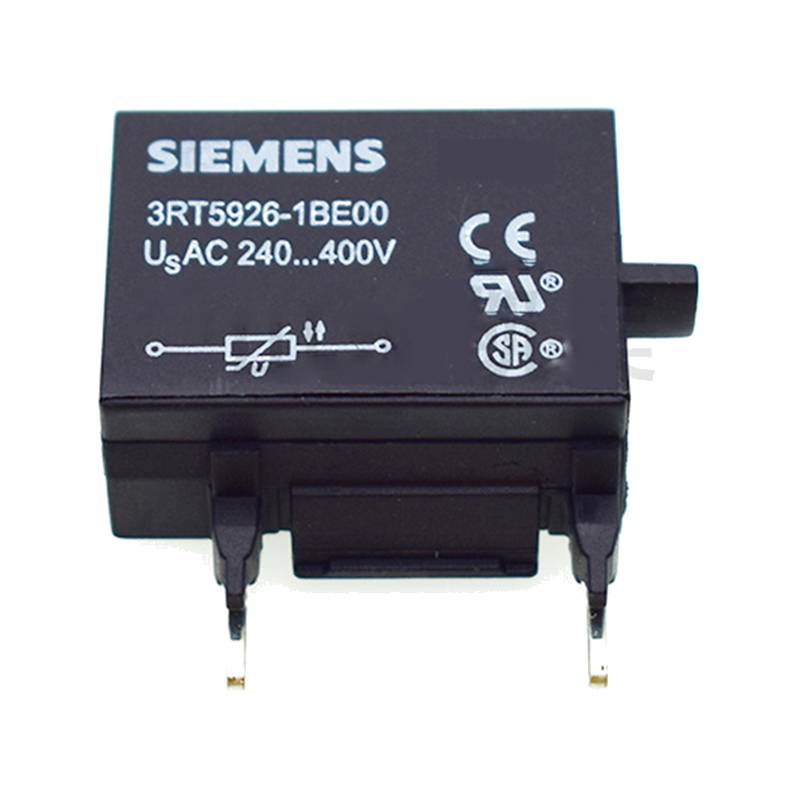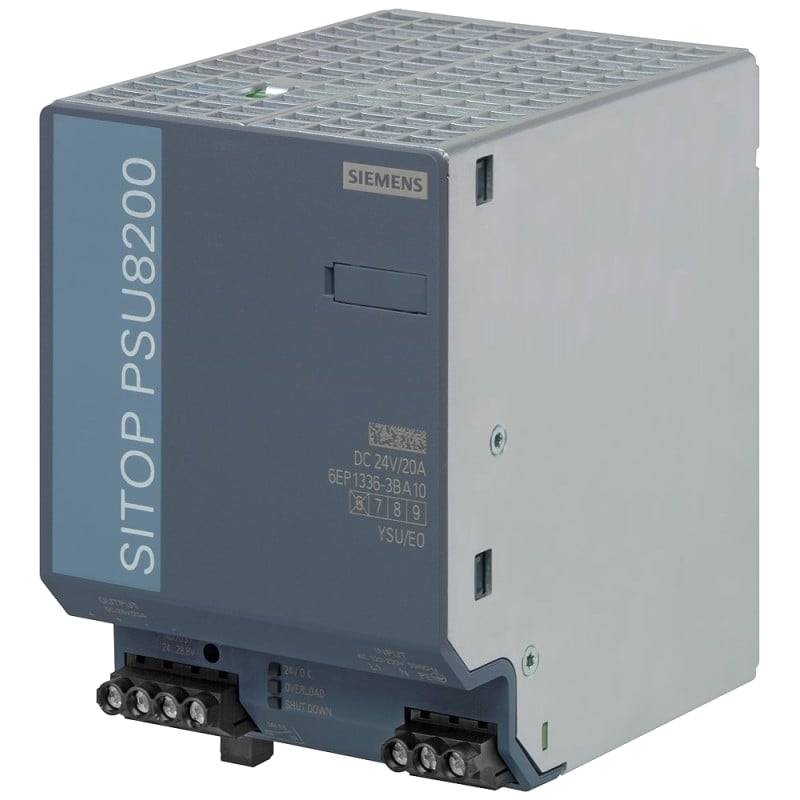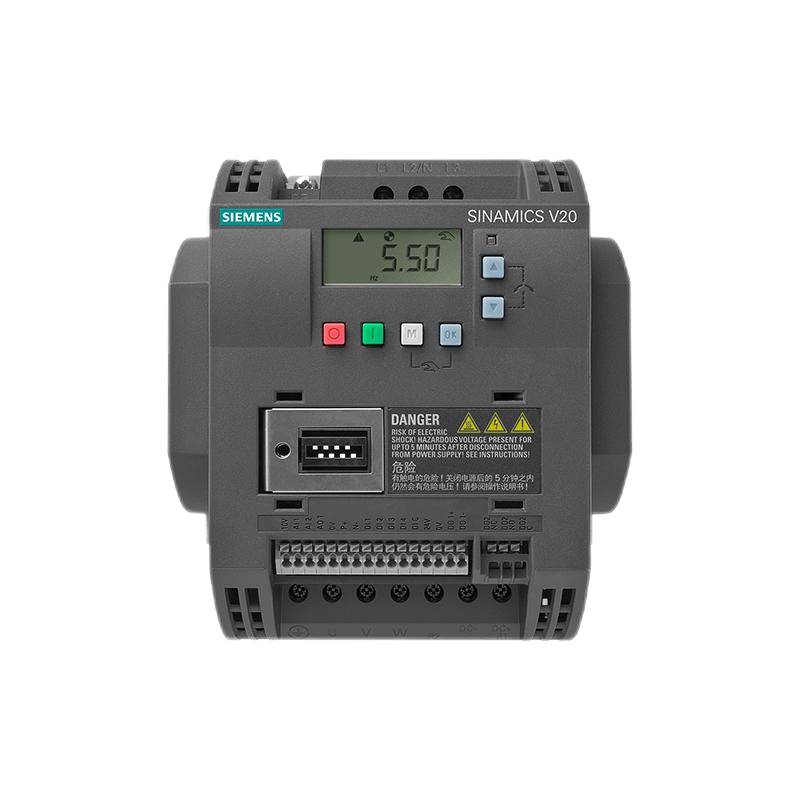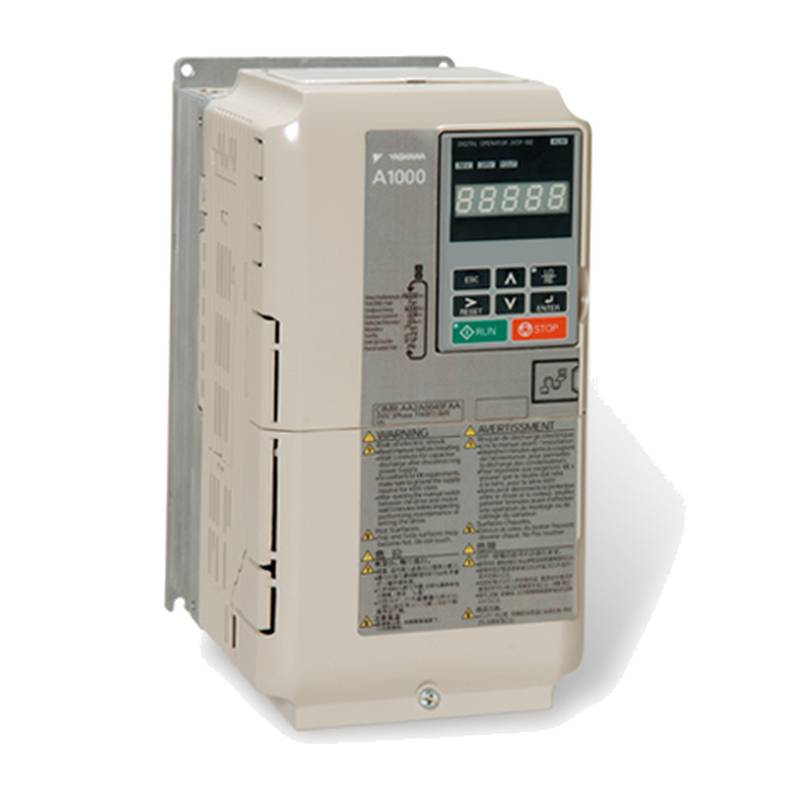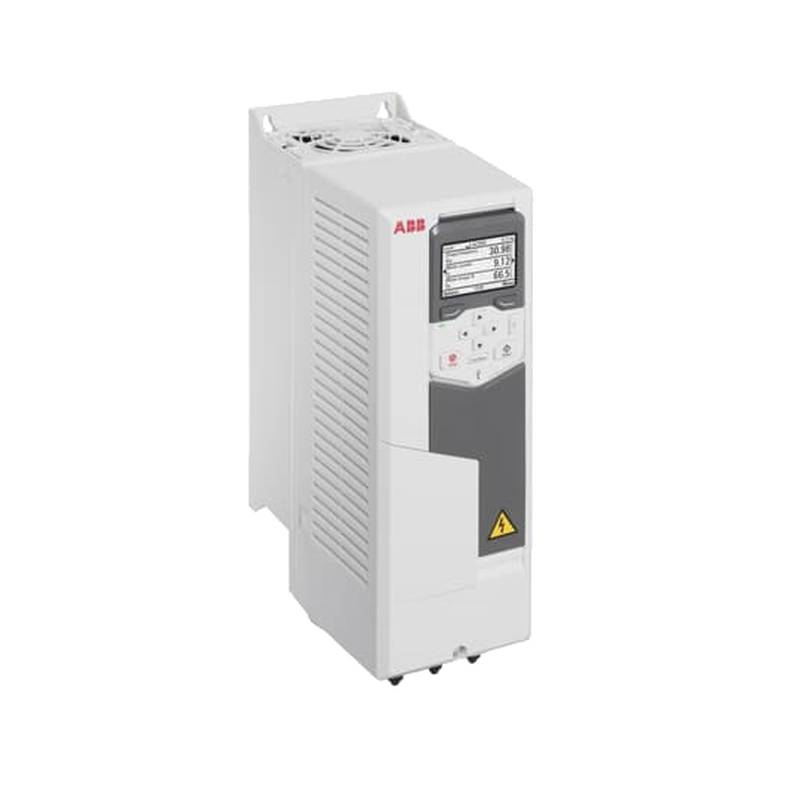
The Siemens 5SU1356-7KK32 Residual Current Circuit Breaker (RCCB) stands as a robust solution for industrial equipment earth leakage protection, offering a 32A rated current, 30mA rated residual current, and a 1-pole + neutral configuration with a Type C tripping characteristic. This device is engineered to provide critical safety by detecting and interrupting fault currents to earth, thereby preventing electric shock hazards and protecting machinery from damage. Its compact design and high breaking capacity make it an indispensable component in modern industrial electrical installations.
Product Specifications
| Feature | Specification |
| :-------------------------- | :----------------------------- |
| Product Type | RCCB |
| Manufacturer | Siemens |
| Model Number | 5SU1356-7KK32 |
| Rated Current (In) | 32A |
| Rated Residual Operating Current (IΔn) | 30mA |
| Number of Poles | 1P+N (1 Pole + Neutral) |
| Tripping Characteristic | Type C |
| Rated Voltage (Un) | 230/400V AC |
| Frequency | 50/60 Hz |
| Breaking Capacity (Icn) | 10 kA |
| Terminal Type | Screw Terminal |
| Mounting Type | DIN Rail |
| Protection Degree | IP20 (enclosure), IP40 (front) |
| Operating Temperature | -25 to +45 °C |
| Compliance Standards | IEC/EN 61009 |
Core Features & Market Positioning
The Siemens 5SU1356-7KK32 RCCB distinguishes itself through its unwavering reliability and advanced safety features, crucial for demanding industrial environments. Its Type C tripping characteristic ensures it can handle inrush currents common in industrial motors and inductive loads without nuisance tripping, a key differentiator from Type B or A devices. This positioning makes it ideal for applications where stable operation is paramount alongside robust protection. The device’s construction adheres to stringent international standards like IEC/EN 61009, assuring users of its quality and performance, a testament to Siemens' long-standing reputation in industrial electrical engineering. The inherent safety provided by its earth leakage detection capability significantly reduces the risk of electrical accidents and equipment burnout, positioning it as a premium, safety-focused component.
Key Application Scenarios
This Siemens RCCB is specifically designed for safeguarding industrial equipment against earth faults. Its primary applications include protecting individual motor circuits, control panels, and machinery powered by single-phase or neutral-carrying three-phase systems where a 30mA sensitivity is required for enhanced personal protection. Industries such as manufacturing, automation, processing plants, and commercial building services can benefit immensely from its reliable performance. It is particularly suited for circuits feeding equipment with moderate inrush currents, such as pumps, fans, and conveyor systems, where the Type C characteristic is advantageous. The 1P+N configuration simplifies wiring in many standard industrial setups, making it a versatile choice for various electrical distribution boards.
Practical System Integration Guidance
Integrating the Siemens 5SU1356-7KK32 RCCB into an industrial electrical system is a straightforward process, typical for DIN-rail mounted devices. Ensure the main power supply is de-energized before commencing any work. Connect the phase and neutral conductors from the upstream protective device (e.g., circuit breaker) to the designated line terminals of the RCCB, typically marked with an "L" and "N" symbol. Subsequently, connect the load conductors for the protected circuit to the corresponding output terminals. Proper grounding of the entire system and the enclosure is critical for the RCCB's effective operation. The output terminals should be clearly marked for phase and neutral, ensuring correct polarity. For systems requiring higher protection levels or specific configurations, consult the manufacturer's detailed installation manual.
Operation and Risk Mitigation
The Siemens 5SU1356-7KK32 operates by continuously monitoring the current flowing through the phase and neutral conductors. If an imbalance occurs, indicating that current is leaking to earth through an unintended path, the RCCB rapidly trips, disconnecting the power supply. This immediate response is crucial for mitigating the risk of electric shock to personnel and preventing damage to equipment due to persistent ground faults. The "Test" button integrated on the front of the device allows for periodic functional checks of the tripping mechanism, a vital practice for ensuring ongoing safety. In the event of a fault, the RCCB's lever will move to the "OFF" position. To reset, ensure the fault has been rectified, then firmly move the lever to the "ON" position. Consistent testing and visual inspection of the device for any signs of damage are essential risk mitigation strategies.
Scalability & Long-Term Value
The Siemens 5SU1356-7KK32 RCCB offers significant long-term value within industrial electrical infrastructure due to its inherent compatibility and Siemens' commitment to product longevity. As a standard DIN-rail mounted device, it seamlessly integrates with a wide array of Siemens' industrial control and distribution components, facilitating easy upgrades or expansions of existing systems. Its robust design ensures a long operational lifespan, reducing the need for frequent replacements. While this specific model focuses on earth leakage protection, its inclusion within the broader Siemens ecosystem allows for future integration with smart monitoring solutions or more advanced protection relays as industrial facilities evolve towards digitalization and the Industrial Internet of Things (IIoT), ensuring continued relevance and support.
---
Frequently Asked Questions
What is the primary function of the Siemens 5SU1356-7KK32 RCCB?
The Siemens 5SU1356-7KK32 RCCB is primarily designed to provide enhanced personal protection against electric shock. It detects residual currents, meaning any imbalance between the current flowing into a circuit and the current returning from it.
This imbalance indicates a potential earth leakage, which could be caused by faulty wiring or accidental contact with a live part. When such a leakage exceeds a safe threshold (30mA in this case), the RCCB rapidly disconnects the power supply.
Its secondary function is to protect electrical installations and equipment from damage caused by persistent earth faults, thereby contributing to overall operational safety and reliability in industrial settings.
How does the Type C tripping characteristic benefit industrial applications?
The Type C tripping characteristic of the Siemens 5SU1356-7KK32 is specifically tailored for industrial environments. It allows for higher inrush currents without causing nuisance tripping.
This is particularly important when protecting inductive loads like motors, transformers, and fluorescent lighting ballasts. These devices draw a significantly higher current for a brief moment upon startup.
By accommodating these temporary overcurrents, the Type C characteristic ensures the continuous operation of essential machinery while still providing sensitive earth leakage protection, offering a balanced approach to safety and functionality.
What are the recommended installation practices for this RCCB?
Proper installation is crucial for the effective and safe operation of the Siemens 5SU1356-7KK32 RCCB. Always ensure the power supply is completely disconnected before commencing any wiring.
Connect the incoming phase and neutral conductors to the designated line terminals and the outgoing load conductors to the respective load terminals, observing correct polarity. Utilize appropriate cable sizes and secure all connections firmly to prevent overheating.
Mount the RCCB securely onto a standard DIN rail within a suitable enclosure to protect it from dust, moisture, and physical damage, ensuring adequate ventilation is maintained. Regularly test the "Test" button to verify the tripping mechanism.
Can this RCCB be used for overload protection?
No, the Siemens 5SU1356-7KK32 RCCB is designed for earth leakage protection only and does not provide overload protection.
Overload protection is typically handled by a separate overcurrent protective device, such as a circuit breaker with thermal and magnetic tripping elements or a dedicated overload relay.
For comprehensive circuit protection, this RCCB should be installed downstream of a suitable circuit breaker or fuse that provides overload and short-circuit protection.
What is the significance of the 30mA residual operating current?
A 30mA residual operating current (IΔn) is considered the threshold for direct contact protection in many standards. This sensitivity level is chosen to protect individuals from severe electric shock.
When the leakage current reaches 30mA, it is likely to cause unpleasant sensations and muscle contractions, but it is generally considered the point below which a sustained grip on a live conductor is unlikely.
The rapid disconnection by the RCCB at this level minimizes the duration and severity of any potential shock, significantly reducing the risk of serious injury or fatality.
How do I test the functionality of the Siemens 5SU1356-7KK32?
The Siemens 5SU1356-7KK32 is equipped with a readily accessible "Test" button on its front panel. Periodic testing is essential to ensure the device remains operational and can respond to earth leakage faults.
To perform a test, ensure the circuit is energized. Press the "Test" button firmly. If the RCCB is functioning correctly, it will trip, and the lever will move to the "OFF" position, interrupting the power to the protected circuit.
If the RCCB does not trip during the test, it indicates a malfunction, and the device must be replaced immediately. It is recommended to test the RCCB regularly, such as monthly, and after any electrical work or power interruptions.
What electrical standards does this RCCB comply with?
The Siemens 5SU1356-7KK32 RCCB complies with crucial international electrical safety standards. It adheres to IEC/EN 61009, which specifically covers residual current operated circuit-breakers with and without integral overcurrent protection for household and similar uses.
This compliance signifies that the product has undergone rigorous testing and meets stringent performance and safety requirements set forth by these globally recognized bodies.
Adherence to these standards ensures that the device provides reliable earth leakage protection and is suitable for use in a wide range of industrial and commercial electrical installations where safety is paramount.
What is the breaking capacity (Icn) of this RCCB?
The breaking capacity (Icn) of the Siemens 5SU1356-7KK32 is rated at 10 kA. This figure represents the maximum fault current that the RCCB can interrupt safely without sustaining damage.
A higher breaking capacity indicates a more robust device capable of handling more severe short-circuit conditions. This 10 kA rating is substantial and suitable for most standard industrial distribution systems.
It is critical that the upstream protective devices (e.g., main circuit breaker or fuses) are selected to ensure that any potential fault current does not exceed this 10 kA limit at the point of installation.
Can this RCCB be used in damp or dusty environments?
The Siemens 5SU1356-7KK32 has an enclosure protection degree of IP20 and a front protection degree of IP40. While IP20 offers protection against solid objects greater than 12.5mm, it does not provide significant protection against water ingress.
IP40 on the front offers some protection against solid objects larger than 1mm, but neither rating is sufficient for direct exposure to water jets or immersion. Therefore, this RCCB is not intended for direct use in excessively damp or very dusty environments without appropriate enclosure.
For such conditions, it is recommended to install the RCCB within a properly sealed industrial control panel or enclosure that provides a higher level of environmental protection suitable for the specific industrial setting.
What is the lifespan and maintenance requirement for this RCCB?
Siemens products are engineered for durability and long operational life. The Siemens 5SU1356-7KK32, like other high-quality industrial components, is designed for extended service under normal operating conditions.
While specific lifespan figures can vary based on usage and environmental factors, regular testing of the "Test" button (as mentioned previously) is the primary maintenance requirement. This ensures its protective function remains active.
Periodic visual inspections for any signs of damage, corrosion, or overheating are also advisable. In industrial settings with heavy usage or potential electrical disturbances, professional electrical assessments may be incorporated into routine maintenance schedules.


















